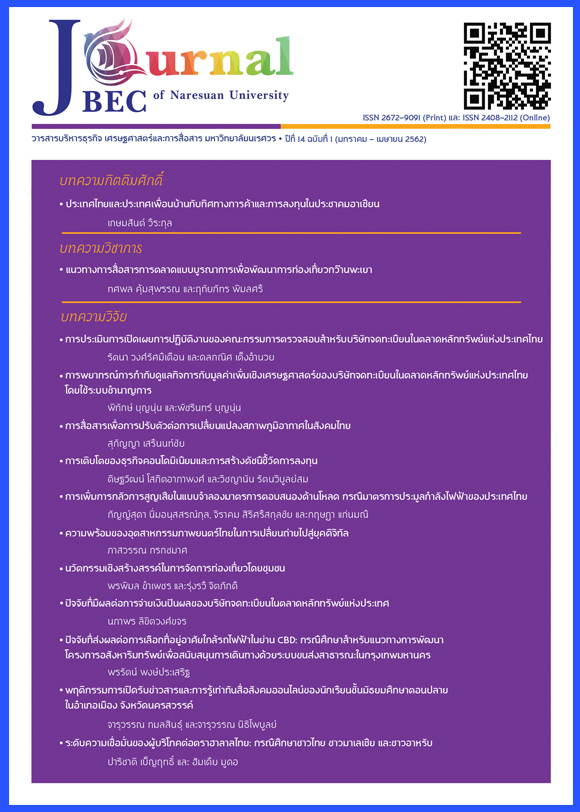การเพิ่มการกลัวการสูญเสียในแบบจำลองมาตรการตอบสนองด้านโหลด กรณีมาตรการประมูลกำลังไฟฟ้าของประเทศไทย
Main Article Content
บทคัดย่อ
การศึกษานี้ดัดแปลงแบบจำลองจากงานของ Aalami, Moghaddam and Yousefi (2010, pp. 245-246) โดยใส่พฤติกรรมการกลัวการสูญเสียและค่าปรับเพื่อศึกษาประสิทธิภาพของมาตรการประมูลกำลังไฟฟ้าของประเทศไทย แบบจำลองที่ดัดแปลงแล้วถูกใช้ในการจำลองสถานการณ์ที่แตกต่างกันของมาตรการประมูลกำลังไฟฟ้าด้วยข้อมูลปริมาณการใช้ไฟฟ้าช่วงสูงสุดของประเทศไทยในปี 2560 จากการไฟฟ้าส่วนภูมิภาค จากนั้นทำการเปรียบเทียบผลทางเศรษฐกิจและดัชนีความสำเร็จของกลยุทธ์ใน 10 สถานการณ์ ผลการศึกษาพบว่า กรณีใช้มาตรการประมูลกำลังไฟฟ้าโดยให้ค่าตอบแทนเท่ากับ 3 บาท/หน่วย โดยมีค่าปรับเท่ากับ 2 บาท/หน่วย และมีค่าดัชนีการกลัวการสูญเสียเท่ากับ 2 มีค่าดัชนีความสำเร็จมากที่สุด และพบว่า ดัชนีความสำเร็จจะผันแปรตามความยืดหยุ่นช่วงเวลาเดียวและความยืดหยุ่นข้ามเวลา โดยถ้าความยืดหยุ่นช่วงเวลาเดียวและข้ามเวลาลดลง ดัชนีความสำเร็จจะลดลงด้วย ซึ่งผลการศึกษาสอดคล้องกับงานของ Aalami, Moghaddam and Yousefi (2010, p. 249) นอกจากนี้ยังพบว่า การลดลงของการใช้ไฟฟ้าสูงสุดขึ้นอยู่กับระดับของการกลัวการสูญเสีย โดยถ้ามีการกลัวการสูญเสียเพิ่มขึ้น การลดการใช้ไฟฟ้าสูงสุดได้มากขึ้นด้วย ซึ่งให้ผลแตกต่างจากงานของ Mohajeryami, Schwarz and Baboli (2015, p. 5) เนื่องจากมาตรการที่ Mohajeryami, Schwarz and Baboli (2015, p. 2) ใช้ไม่มีค่าปรับ
Article Details
References
2. Aalami, H. A., Yousefi, G. R. and Moghaddam, M. P. (lecturer). (April 21-24, 2008). Demand response model considering EDRP and TOU programs. In Transmission and Distribution Conference and Exposition (pp. 1-6). Chicago: IEEE/PES.
3. Energy Policy and Planning office. (March 3, 2016). Demand response. Retrieved February 7, 2018, from http://www.eppo.go.th/index.php/th/electricity/ define-electricity/demand-response
4. Energy Policy and Planning office. (February 24, 2017). Emergency demand response program: EDRP. Retrieved January 20, 2018, from http://www.eppo.go.th/index.php/th/plan-policy/climatechange/thailand/eqmplan/item/11983
5. Jirapraditkul, V. (Lecturer). (September 6, 2017). Energy 4.0 the chance of Thai industries. In Energy Symposium 2017 (pp. 1-20). Bangkok: Centara Grand at Central Plaza Ladprao.
6. Jitmaneeroj, B. (2011). Behavioural finance. Thailand Economic and Business Review, 7(3), 12-15.
7. Khajavi, P., Arani, A. B. and Monsef, H. (Lecturer). (May 8-11, 2011). Identification of appropriate buses for implementation of smart grid in order to improve system efficiency. In 10th International Conference on Environment and Electrical Engineering (pp. 1-4). Rome: SGM Conference center.
8. Kobberling, V. and Wakker, P. P. (2005). An index of loss aversion. Journal of Economic Theory, 122(1), 119-131.
9. Marwan, M., Ledwich, G., Ghosh, A. and Kamel, F. (Lecturer). (Nov 13-16, 2011). Integrating electrical vehicles to demand side response scheme in Queensland Australia. In 2011 IEEE PES Innovative Smart Grid Technologies (pp. 1-6). Perth: The Pan Pacific Hotel.
10. Mohajeryami, S., Schwarz, P. and Baboli, P. T. (Lecturer). (Oct 4-6, 2015). Including the behavioral aspects of customers in demand response model: Real time pricing versus peak time rebate. In North American Power Symposium (NAPS) (pp. 1-6). Charlotte: The University of North Carolina.
11. News Term TCIJ. (March 5, 2017). Open the plan of Ministry of Energy use 'demand response' to reduce the electricity peak in 2017. Retrieved January 24, 2018, from https://www.tcijthai.com/news/2017/3/scoop/6810
12. PG & E. (February 21, 2013). Capacity bidding program. Retrieved February 26, 2018, from https://www.pge.com/en_US/business/save-energy-money/energy-management-programs/third-party-programs/capacity-bidding.page
13. Pongwiritthon, R., Chongesiriroj, S., Pakvipas, P. and Kantawongwan, B. (2017). Information system development for community management on hydroelectric energy: Doi Pu Muen. Journal of Business, Economics and Communications, 12(2), 79-92.
14. Provincial Electricity Authority. (July 31, 2017). Electricity tariffs. Retrieved January 1, 2018, from https://www.pea.co.th/Portals/0/Document/Rate2015Update.pdf
15. Thaler, R. H. (2016). Behavioral economics: New economics look at people far more than economic animals. (Tulayasathien, S. and Kusolvititkul, P., Trans.). Bankok: openworlds. (Origianl work published 2015).
16. Zarei, A. (2012). Evaluation of emergency demand response programs based on power model in power systems. International Journal of Academic Research in Applied Science, 1(4),
35-46.

